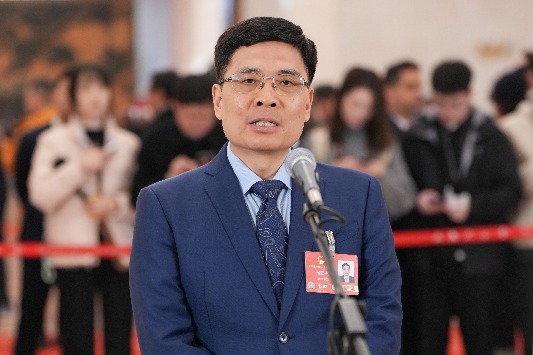Stable economic growth needs consumption


China is striving to cross the threshold of high-income countries. Thus, this year's Government Work Report set a GDP growth target of around 5 percent and prioritized stimulating consumption as its primary policy focus for 2025. This economic blueprint, reflecting China's aspirations, requires sustaining medium-rate growth alongside efforts to ensure the nominal growth rate outpaces the real growth rate.
China should pivot its economic growth model from investment and export reliance to innovation and domestic consumption-driven, to achieve the 5 percent annual growth target outlined in this year's Government Work Report. This shift may face headwinds from structural deviation of consumption, yet successful reforms would bring more support to the stable and medium-rate growth of China's economy.
In the past two years, the economic recovery process after the pandemic has shown an overall upward trend in China, but still faces the pressure of insufficient demand, which is not a lack of investment, but a lack of consumption.
From an international perspective, there is currently a gap of nearly 20 percentage points between China's consumption-to-GDP ratio and the global average level. In terms of purchasing power parity, compared with OECD countries at roughly the same stage of development as China, the household consumption, service consumption and final consumption in China are about one-quarter to one-third different from the former. These reflect a structural deviation in China's consumption patterns, influenced by several factors.
On the one hand, China's basic public services are facing problems such as low overall quality and large internal disparities. At present, the monthly pension of retirees from urban government organs and institutions versus other urban retired workers stands at about 6,000 yuan ($826) and about 3,000 yuan, respectively.
However, the gap between urban and rural areas is significant. Unlike urban residents, rural residents — who make up 95 percent of participants in the urban and rural residents' pension insurance system — receive a monthly pension of just 220 yuan, which is just one-fifteenth of that received by urban retirees.
On the other hand, the level of urbanization is low. In the services consumption sector, demand for goods has largely reached saturation. Services consumption — closely linked to urbanization — such as medical care, education, social security, culture and entertainment, remains difficult to access in traditional rural areas or underdeveloped counties. Even if residents are willing to consume certain goods or services, they often cannot due to a lack of services or high costs. As urban areas provide a high-quality services consumption environment, China's population has increasingly migrated to urban centers, especially large first-tier cities in recent years. Therefore, enhancing urbanization is crucial for expanding services consumption.
A more essential reason for China's consumption challenges is its wide income gap. Currently, China's middle-income group consists of about 400 million people, but there are still about 900 million relatively low-income individuals. International experience shows that, if the middle-income group does not account for the majority of population, it is prone to confront insufficient demand in the second half of the medium-speed growth period.
At the same time, the Chinese government holds a high share of national assets, which has historically facilitated industrialization and investment-driven growth by prioritizing savings and investment over consumption. However, this imbalance has contributed to China's persistently low consumption rate.
The Chinese Academy of Social Sciences said China's net social assets in 2022 totaled approximately 756 trillion yuan, of which government-held assets accounted for about 291 trillion yuan, or roughly 38 percent. In contrast, in the global context, especially in OECD countries, the proportion of government-held assets rarely exceeds 10 percent. Moving forward, more resources should be allocated to consumption, shifting from an investment-driven model to a consumption-driven model.
Economic growth consists of two dimensions — its height and breadth. The height of growth is primarily achieved through innovation, openness and reforms that enhance economic efficiency and expand opportunities. In China, the emergence of technologies such as DeepSeek and humanoid robots demonstrates great development potential and deserves recognition and focus.
However, the importance of the "breadth" of economic growth has been ignored at some extent. China's economy is facing a number of problems now, including low prices, the gap between nominal and real growth, high debt, and overcapacity, all of which are rooted in insufficient end-use demand. Insufficient consumption reflects a lack of economic breadth and is closely tied to factors such as education, social security, human capital development and social mobility, which shape overall demand for productive capacity.
After subtracting productive investment from GDP, the sum of consumption and nonproductive investment — mainly real estate and infrastructure — represents final demand. Though real estate and infrastructure in China have expanded rapidly over the past few years, both sectors' growth momentum has significantly moderated these days, especially the real estate has confronted a sharp decline, exposing the problem of low consumption-to-GDP ratio.
To solve the problem of insufficient demand and achieve the growth target, this year's Government Work Report attaches great importance to consumption and prioritizes stimulus of it as its primary policy focus. It is required to address structural deviations so that the low-income segment with the greatest consumption potential can increase their spending power.
China should take efforts to steadily expand domestic demand. Accelerating urbanization and narrowing the income gap — with a particular focus on social security — are crucial steps. One approach could involve reallocating part of the government's stimulus funds into the basic pension insurance fund for urban and rural residents, effectively doubling the monthly pension for 170 million rural participants, from about 200 yuan to 400 yuan.
Moving forward, State-owned capital should be transferred to the pension fund on a large scale, with priority given to the basic pension insurance fund for urban and rural residents. In cities with large numbers of migrant workers, it is essential to gradually enhance social security and pension payment mechanisms, where some progress has already been made. Furthermore, the government should liberate the social productive forces in the integrated development of urban and rural areas, promote the two-way smooth flow of production factors such as people, land and capital between the two areas, and drive the second wave of urbanization in China.
Studies suggest that rural residents, as China's lowest-income group, have a higher propensity to consume. If 1 trillion yuan were allocated to them, their marginal propensity to consume is estimated at 0.8, meaning 800 billion yuan would be directly spent on consumption. From an academic perspective, given a consumption multiplier of approximately 1.5, this could drive GDP growth by about 1.2 trillion yuan, contributing roughly 1 percentage point to annual GDP expansion — an important step toward economic stability.
The views do not necessarily reflect those of China Daily.
The writer is vice-chairman of the China Development Research Foundation and deputy director of the Committee on Economic Affairs of the CPPCC National Committee.




































